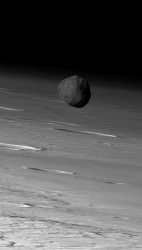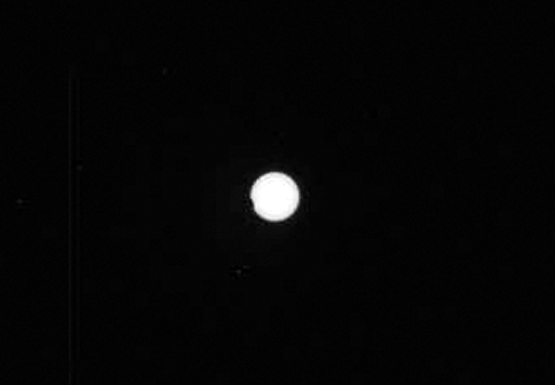Yes, Mars gets eclipses too! This brief animation, made from ten raw subframe images acquired with Curiosity’s Mastcam on September 13 — the 37th Sol of the mission — show the silhouette of Mars’ moon Phobos as it slipped in front of the Sun’s limb.
The entire animation spans a real time of about 2 minutes.
 As a moon Phobos really is an oddity. In addition to its small size – only 8 miles (13 km) across at its widest – and irregular shape, it also orbits its parent planet at a very low altitude, only 5,840 miles (9,400 km) and thus needs to travel at a relatively high velocity in order to even stay in orbit. Phobos actually orbits Mars over three times faster than Mars rotates, appearing to rise in Mars’ western sky. And its orbit is so low that it can’t even be seen from the polar regions!
As a moon Phobos really is an oddity. In addition to its small size – only 8 miles (13 km) across at its widest – and irregular shape, it also orbits its parent planet at a very low altitude, only 5,840 miles (9,400 km) and thus needs to travel at a relatively high velocity in order to even stay in orbit. Phobos actually orbits Mars over three times faster than Mars rotates, appearing to rise in Mars’ western sky. And its orbit is so low that it can’t even be seen from the polar regions!
Since Phobos, and its even more petite sibling Deimos, are so small, the Mars rovers won’t ever see a total solar eclipse. In fact these events are often referred to as transits rather than actual eclipses.
This isn’t the first time an eclipse was captured by a Mars Exploration Rover; Opportunity witnessed a similar partial eclipse of the Sun by Phobos in December 2010, and Spirit caught a lunar (or “Phobal?”) eclipse on camera back in 2005, when the moon passed into the shadow of Mars.
Curiosity’s find was no accident, either, as mission engineers had the Mastcam already positioned to capture the event. Preparation really pays off!
See the latest images and news from the MSL mission here.
Images: NASA/JPL-Caltech/Malin Space Science Systems. Animation by Jason Major. Inset image: Phobos as seen by Mars Express ESA/DLR/FU Berlin (G. Neukum)
UPDATE 9/19/12: See a close-up animation of the eclipse event here.


Bitesize fact: Because Phobos’ orbital period is faster than Mars’ rotation, tidal deceleration is decreasing its orbital radius at the rate of about 20 metres per century.
Isn’t one of the hypotheses of Phobos’ origin that it came from Mars in the first place, as the result of an impact event? If so, only fitting that it will one day return from whence it came.
Affirmative. Also, that hypothesis suggests that Mars was once surrounded by numerous Phobos- and Deimos-sized objects resulting from a collision with a large planetesimal.